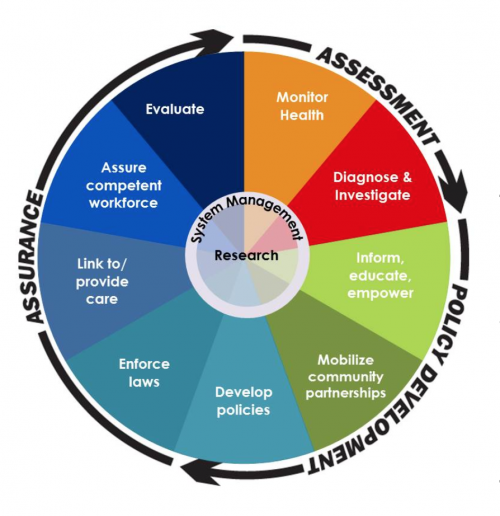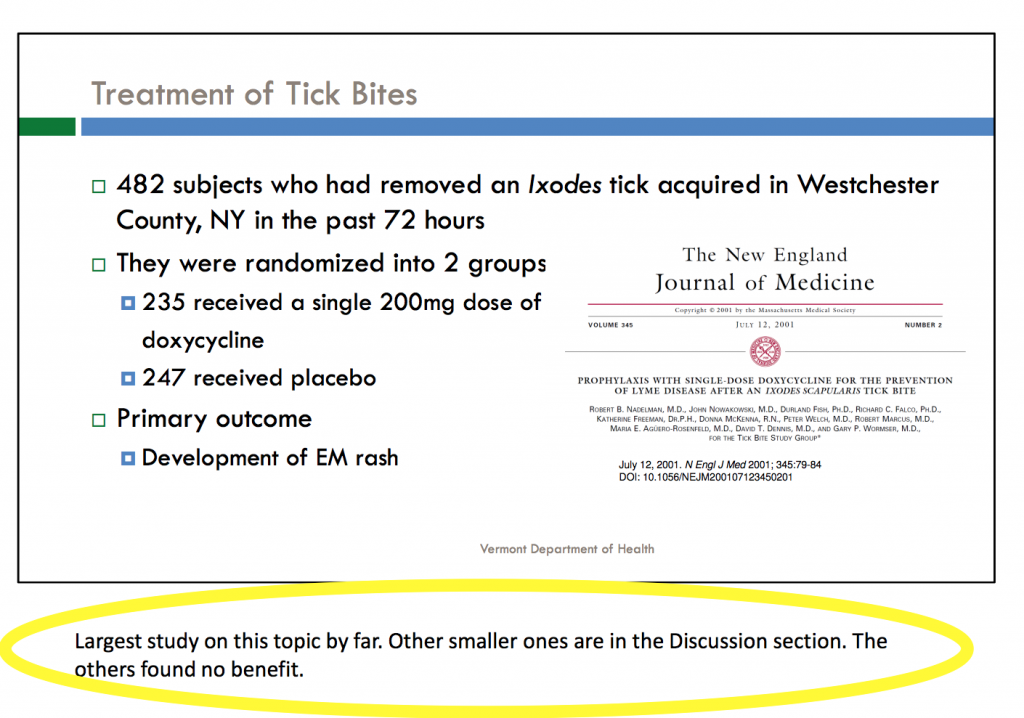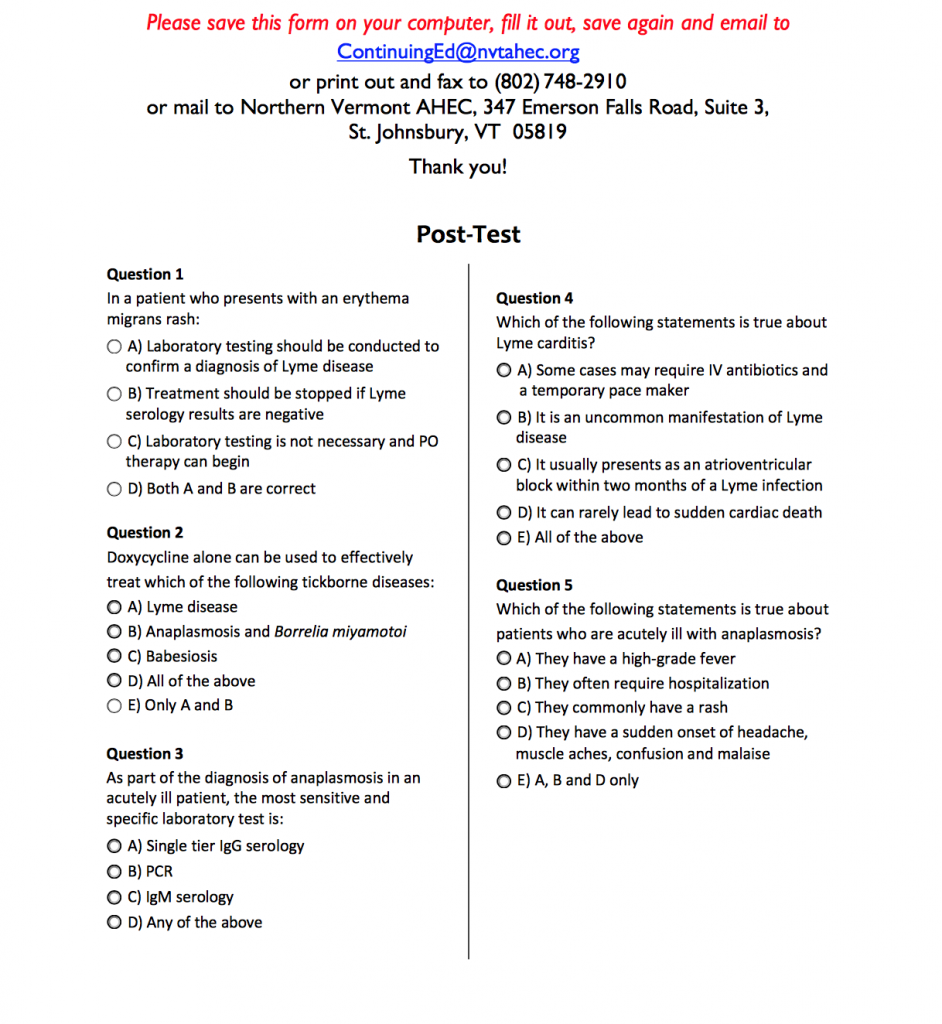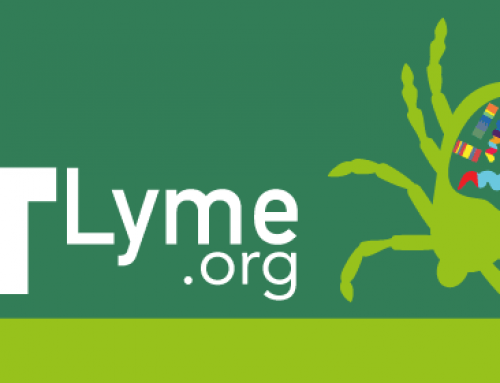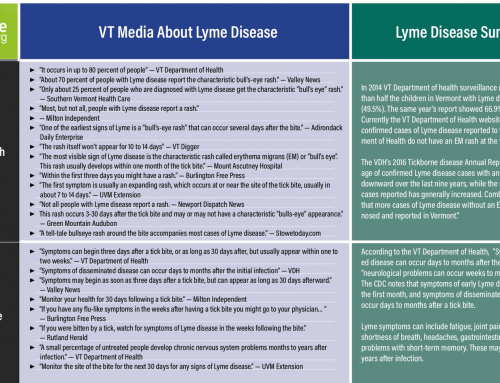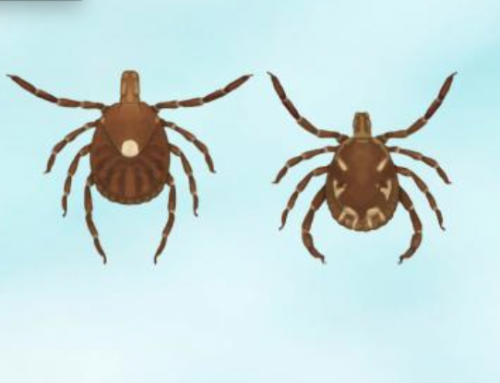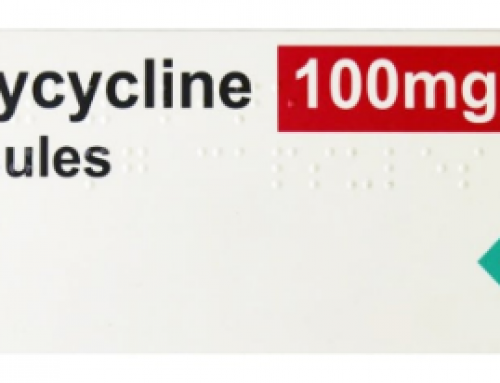According to the CDC, Vermont has the second-highest 3-year average incidence of Lyme disease in the USA, and other tickborne infections are increasing in Vermont. This document was respectfully submitted to Dr. Mark Levine, Commissioner of Health at the Vermont Department of Health, with the end goal that VTLyme.org and the Vermont Department of Health work together to address and reduce the impact of tickborne diseases on Vermonters. VTLyme.org and the VDH share common goals: the prevention of Lyme disease and tickborne diseases, the education of Vermonters and their providers about the signs and symptoms of tickborne illnesses, and ensuring Vermonters have access to well-informed providers who are comprehensively trained in the diagnosis and treatment of tickborne diseases.
Suggested 2020 collaboration efforts:
- VTLyme.org invites the VDH to review and contribute to our Guide to the Diagnosis of Lyme and Tickborne Diseases in Vermont, to be published in May 2020
- The VTLyme.org website averages more than 60,000 unique visitors per year, which is greater than the current reach of the VDH tickborne diseases web pages. The VDH could communicate information through VTLyme’s website and social media accounts about VDH programs and initiatives related to tickborne diseases
- VTLyme.org has created fact sheets, prevention posters, and informational brochures designed for specific populations in Vermont (daycares, elementary schools, sports programs, elders, agricultural workers, outdoor recreationalists, etc.) that could be utilized and distributed by the VDH; in turn VTLyme.org could distribute VDH resources and materials
- The VDH and VTLyme.org could collaborate on tick bite prevention education throughout Vermont, extending the reach and efficacy of the highly successful “Be Tick Smart” campaign.
- The VDH and VTLyme.org could collaborate to create opportunities for Vermont’s health care providers to become better trained in the diagnosis and treatment of tickborne diseases
- VTLyme would like to support the VDH by encouraging Vermont’s health care providers to report cases of Lyme and tickborne diseases, and complete follow-up investigations to increase the accuracy of the VDH surveillance numbers
Importantly, a collaboration would show Vermonters that the VDH is willing to work closely with reputable, local community partners to address an issue that affects the health of thousands of Vermonters and their families, prioritizing the well-being of Vermonters over the national controversies about Lyme disease. The goal of providing as much evidence-based, peer-reviewed information as possible to Vermonters and their health care providers is shared by both the VDH and VTLyme.org, and it would make sense for us to collaborate in the best interest of the many Vermonters whom both organizations serve.
Important note about the scope of VTLyme.org efforts:
VTLyme.org does not and will not recommend any specific form of treatment for tickborne diseases. VTLyme.org considers this the purview of licensed health care providers.
VTLyme.org does advocate for providers to have access to accurate data and to equitable information from the VDH, including as much peer-reviewed, evidence-based information about the diagnosis and treatment of Lyme disease and tickborne diseases. This is essential for Vermonters, and their medical providers, to make truly well-informed decisions about their health.
Summary of Suggestions:
In addition to collecting data and sharing prevention information so Vermonters can prevent infection, the VDH also “strives to inform the state’s health care community about the latest tickborne disease developments to improve the timeliness and accuracy of diagnoses” (VDH 2017 Tickborne Disease Annual Report, published June 2019).
The ‘Be Tick Smart’ campaign has been extremely successful at increasing Vermonters’ awareness about the prevention of tick bites. We see important shortcomings, however, in the way the VDH is informing and educating Vermont’s health care providers about the signs, symptoms and diagnosis of Lyme disease. These include:
- Inconsistencies with the collection and reporting of data
- Significant problems with the Lyme disease portion of the VDH’s webinar for healthcare providers
- Lack of updated and equitable information for health care providers in Vermont about the diagnosis and treatment of Lyme and tickborne diseases.
In addition, the stated efforts of the VDH in their most recent tickborne disease annual report are incongruent with visible efforts. This means there are many missed opportunities to help Vermonters and their health care providers understand their risk for tickborne disease, and the signs and symptoms that are crucial in the early diagnosis of tickborne diseases, often preventing long-term health complications and poor treatment outcomes.
This document highlights areas where the VDH could improve the way tickborne disease is addressed in Vermont, especially Lyme disease. VTLyme.org would like to partner with the VDH to improve health outcomes for all Vermonters.
I. INCONSISTENCIES WITH THE COLLECTION AND REPORTING OF DATA
Reporting
Data in the 2016 VDH Tickborne Disease Annual Report are incongruent with data in the 2017 report and the VDH webinar. For example, a nine-year trend regarding the declining presence of EM rash in confirmed cases of Lyme disease, as noted in the 2016 report (graph below), does not appear in the 2017 report.
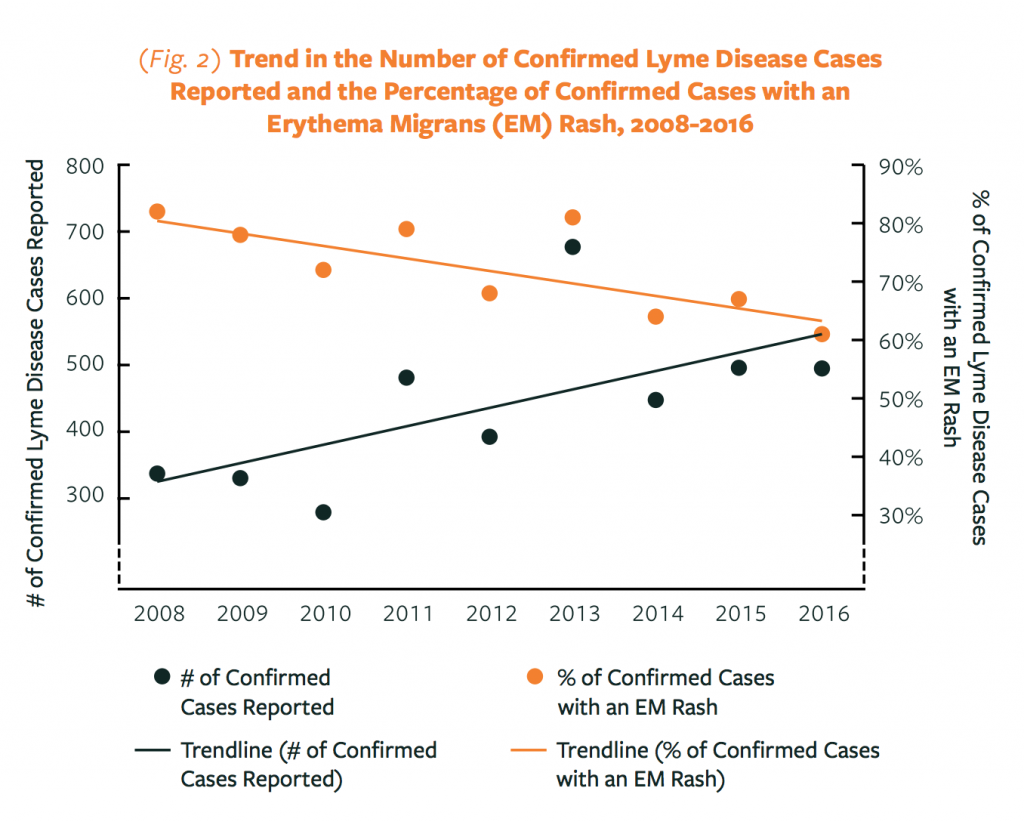
From the 2017 report:
“During 2005–2017, more than 70% of Vermonters with confirmed cases of Lyme disease developed an erythema migrans (EM) rash, a physical finding that can be very helpful for diagnosis because it is fairly unique to Lyme disease.”
From the 2016 report:
“This common association between Lyme and the EM rash has led to the misconception that an EM rash must be present for a person to have Lyme disease.”
In the VDH webinar for providers, Dr. Dejace quotes the 2017 report statistic, but neglects the important trend shown in the graph above. Vermont patients with confirmed Lyme disease increasingly present without EM and therefore require a more nuanced clinical diagnosis from a health care provider. (As noted by the 2016 VDH report, Lyme disease presenting without EM can be confusing to patients and providers.)
Surveillance
According to the VDH and CDC, the incidence of Lyme disease in Vermont went down in 2018. However, according to the VDH’s 2020 ‘Performance Scorecard on Vector-Borne Diseases,’ the rate of completed investigations of Lyme disease case reports dropped sharply that year from 91- 92% in 2015–2017, to 76% in 2018.
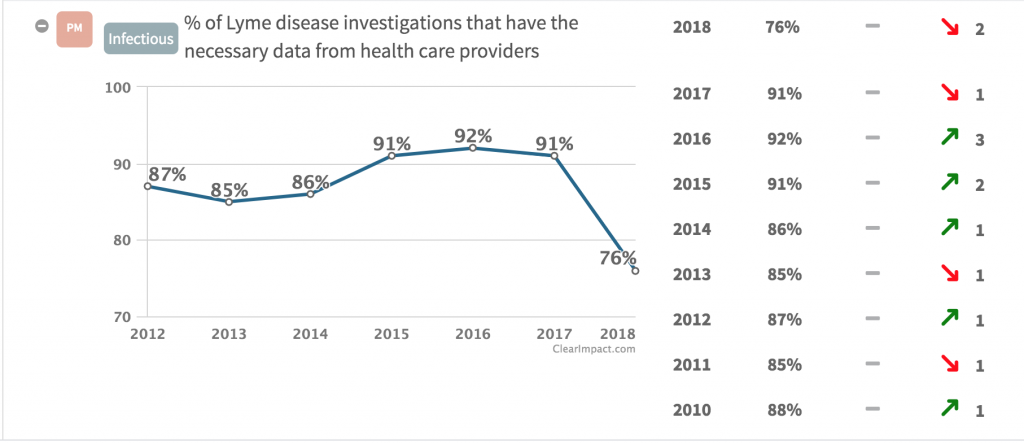
From 2015 to 2017, when more than 90% of reports were investigated, VT had one of the highest incidence rates in the US. In 2018, when only 76% of reported cases were fully investigated, the number of Vermont cases reported to the CDC dropped sharply. As the VDH website notes, “these [incomplete] investigations are closed and not counted towards surveillance numbers.”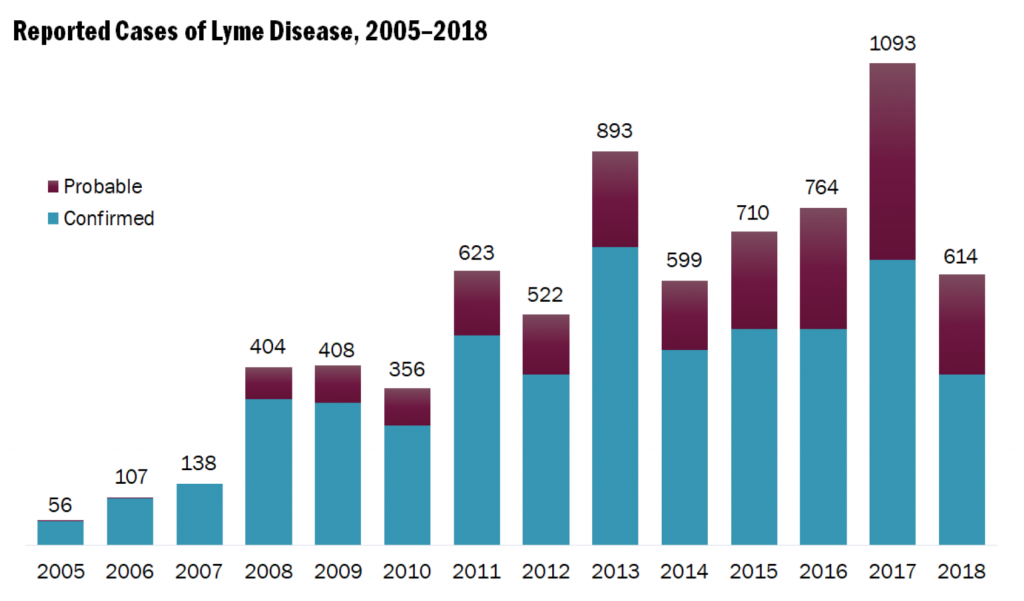
The VDH states “The incidence of Lyme disease is an important indicator” but the 2018 data reported about the incidence of Lyme disease, as currently published on the VDH website, does not mention that these numbers are likely inaccurate due to the low number of case study investigations completed compared to previous years.
II. SIGNIFICANT PROBLEMS WITH THE LYME DISEASE PORTION OF THE VDH WEBINAR FOR HEALTH CARE PROVIDERS
The Webinar
Review this VTLyme.org post for a thorough assessment of this webinar with specific details for each point made below, and for additional concerns not listed below.
The VDH goals stated for this webinar include: “defining symptoms… identifying tests… and describing the appropriate use of antibiotics in the treatment of Lyme disease.” As of January 26, 2020 the webinar (posted in Sept 2018) had 201 views.
- Symptom data specific to Vermont is not accurately reported
- Less common but significant symptoms in all stages of Lyme disease are not covered or discussed
- The timing of symptoms as described by Dr. Dejace in the webinar are incongruent with information on the VDH website and VDH press releases
- The webinar says “clinical diagnosis is important” but offers no comprehensive guidelines for clinical diagnosis of Lyme disease, instead emphasizing lab tests/diagnostics
- Concerns about prophylactic doxycycline for Lyme disease are not discussed, even though Dr. Dejace’s presentation slide notes say other studies “found no benefit”
- Research that does not reflect the diagnostic circumstances, timelines, treatment, or outcomes of many Vermonters with Lyme disease is presented as evidence for “good clinical outcomes” for all
- Dejace asserts there is a “a strong consensus in the medical community” about treatment of Lyme disease, yet there is currently ongoing research, discussion, and debate by physicians and scientists regarding the best treatments for Lyme and other TBDs.
The Five-Question CE Credit Test
Truly equitable information about the diagnosis and treatment of Lyme and TBDs would acknowledge that we don’t know what we don’t know. That being said, there is enough we do know to provide a basis for standard care. Does the 5-question post test for CE credits (only 3 of which are about Lyme disease) truly ensure that Vermont’s health care providers are adequately trained in the objectives of this webinar? For a disease that is endemic in our state, where we often lead the country in incidence rate, and where children ages 5-14 are at highest risk, Vermont should have comprehensive training and high expectations for health care providers in the diagnosis and treatment of Lyme disease. It is commendable that the VDH has created a webinar to help Vermont’s health care providers better diagnose and treat tickborne diseases, but this webinar reveals a need for additional, thorough and equitable information regarding the clinical diagnosis and effective treatment of Lyme disease.
III. LACK OF UPDATED AND EQUITABLE INFORMATION FOR HEALTH CARE PROVIDERS IN VERMONT ABOUT THE DIAGNOSIS AND TREATMENT OF LYME DISEASE AND TICKBORNE DISEASES
Information for Health Care Providers on the VDH website
The only information visible on the VDH website link “Tickborne Disease Resources for Health Professionals” is the VDH webinar. (Please see VTLyme.org’s post about the VDH webinar for details about problems with the Lyme disease section of the webinar.)
A link to the CDC’s most recent ‘Tickborne Diseases Reference Manual for Health Care Providers’ is on the page, but it is not visible unless a provider first clicks the tab “Help Patients Prevent Tickborne Disease.”
Other Information for Health Care Providers in Vermont
UVM’s project ECHO was a 2019 distance learning project to help Vermont’s health care providers learn about the treatment of TBDs. Unfortunately, it uses many of the same slides, statistics and research noted as problematic in the VDH webinar. For example:
- Shows EM present in +- 75% of cases when published VDH data says it is closer to 60% in confirmed Lyme disease cases in Vermont
- Focuses only on the arthritic presentation of late disseminated Lyme disease. According to the American Lyme Disease Foundation (ALDF), late-stage Lyme disease can include “disabling neurological disorders, disorientation, confusion, dizziness, short-term memory loss, inability to concentrate, finish sentences or follow conversations, mental “fog” and numbness in arms/hands or legs/feet”.
- Dejace cites, in his section on ‘Post Treatment Lyme Disease Syndrome’ (PTLDS), a 2003 study about long-term follow up on patients with culture-confirmed Lyme disease. The subjects were “adult patients diagnosed with early Lyme disease, EM, who were treated at the time of their diagnosis.” While this research would be appropriate in the section on early Lyme disease, it does not represent outcomes of patients with disseminated or late-treated Lyme disease, or related PTLDS.
- A CDC resource offered as a link in this ECHO presentation states the “pathogenesis of post-Lyme disease symptoms [and by reasonable assumption, also the treatment] is an area of great controversy and it’s likely that different factors will play a role in each individual case.” However, Dejace describes a “consensus in the medical community” regarding the treatment of Lyme disease/PTLDS.
Tickborne Disease Reporting
While “health professionals in Vermont are required to report all cases of Lyme disease,” the cases are only counted toward surveillance numbers if the case investigation is completed. As noted earlier, approximately 1 out of every 4 cases reported in Vermont were not counted toward 2018 CDC surveillance numbers, versus over 90% in previous years.
Unlike other endemic states where information and criteria about reporting and report forms are available online, the VDH asks health care providers to “report a suspected or confirmed case of disease, contact the Infectious Disease Epidemiology Program at 802-863-7240 or 800-640-4374 (within Vermont only) from 7:45 a.m. through 4:30 p.m. on business days.”
While the VDH has “developed a novel, Microsoft Access-based system to import Lyme disease case data from our infectious disease surveillance system database” it also notes, “many of the Lyme disease reports we receive are delivered on paper, requiring staff to manually enter data into our database”. The VDH states they intend to “work with information technology partners to increase the number of reports we receive electronically” but there is no specific plan or timeline stated for the completion of this task.
Incomplete Tickborne Disease ‘Signs and Symptoms’ Information
The VDH’s ‘Be Tick Smart ‘campaign has been successful at informing Vermonters about the prevention of Lyme disease, but the explanation for Vermonters about the signs and symptoms of tickborne diseases is extremely limited.
Timing of Symptoms
The ‘Watch’ section of ‘Be Tick Smart’ notes: “Watch for symptoms of tickborne illness for three days to 30 days after a tick bite. Symptoms may include fever/chills, rash, headache, joint pain, muscle aches, or fatigue. Not all people with Lyme disease report a rash.” According to Dr. Dejace’s webinar and the ALDF, the symptoms of tickborne illnesses “can present days, months or years after infection.”
The ‘Be Tick Smart’ campaign, lists 6 tickborne disease symptoms to watch for: Fever/chills, rash, headache, joint pain, muscle aches, fatigue.
A comprehensive list of signs and symptoms of tickborne diseases (as listed by the CDC, VDH & ALDF) include: fever/chills, rash, headache, joint pain, muscle aches, severe fatigue, stiff, aching neck, tingling/numbness in extremities (peripheral nervous system involvement), painful arthritis, facial palsy, severe headaches, swelling of joints, cardiac abnormalities, central nervous system (CNS) involvement leading to cognitive (mental) disorders, nausea and gastrointestinal problems, anxiety/panic attacks, memory loss.
Memory of a Tick Bite
The ‘Be Tick Smart’ campaign states “Tell your health care provider about your recent tick bite, when the bite occurred and your outdoor activities” however the CDC states “most patients don’t remember being bitten by a tick” and therefore it’s exposure to ticks that is relevant to clinical diagnosis, not the memory of a tick bite. It is very likely that a patient in Vermont with a “bulls-eye rash”, or a known tick bite followed by a fever and joint pain, will be diagnosed correctly. However, Vermonters with tickborne infections who do not present with immediate and common symptoms may remain undiagnosed and untreated, increasing their risk for longer-term health complications. These poorer outcomes could be prevented by informing Vermonters and their health care providers about the full range of signs and symptoms of Lyme and tickborne diseases, symptom timing, and that (according to the CDC) most patients do not remember a tick bite.
IV. DISCREPANCIES BETWEEN STATED VDH ACTIVITY IN ANNUAL REPORTS AND ACTUAL, VISIBLE EFFORTS
Tickborne Disease Awareness Month
The 2017 Tickborne Disease Annual Report (published in June, 2019) states that the VDH “Organized the state’s ‘Tickborne Disease Awareness Month’ in May” with an official proclamation by the Governor’s office, a press release, numerous media interviews and a partnership with Green Up Vermont.”
- From 2016-2019 only two press releases from the VDH (May 2, 2016 and May 24, 2017) mention “Tickborne Disease Awareness Month” in Vermont
- The VDH Facebook Page from 2017- 2020 had only a single post related to “Tickborne Disease Awareness Month” (referring to the 5/24/17 press release)
- In 2019 there was no proclamation signed by the Governor about “Tickborne Disease Awareness Month.” The current VDH Calendar lists no tickborne disease related events for May, 2020.
Press Releases:
2018
While the Governor signed a proclamation designating May 2018 “Tickborne Disease Awareness Month” in Vermont, in the entire year of 2018 the VDH website lists only one press release about tickborne diseases. This was about Lyme carditis in Vermont. There was no press release about “Tickborne Diseases Awareness Month”, and a search of VDH press releases in 2018 about ticks or tickborne diseases had zero results.
2017
In 2017 there were two VDH press releases about tickborne diseases, one in October, and one on May 24th (toward the end of “Tickborne Disease Awareness Month”).
2016
A search for “Lyme” in the VDH 2016 press releases revealed zero results, however a search for “Tick” did show three press releases in 2016, in May, July and September. The text within the May press release does mention “Tickborne Disease Awareness Month”.
2019
Significantly, a search showed zero VDH press releases in 2019 about tickborne diseases


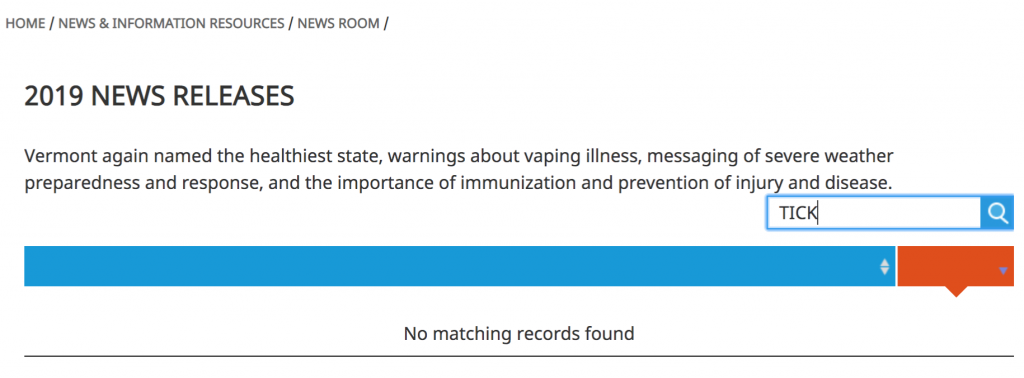

A recent VDH promotion about healthy New Years resolutions in 2020 mentions the prevention of tick bites and includes a link to the VDH ‘Be Tick Smart’ prevention web page. However, efforts like these have been countered by the VDH’s own representatives:
In a 2019 VT Digger article about the increase of tick related ED visits in Vermont, the VDH’s representative Natalie Kwit is interviewed; “Prevention tips are kind of moot now, but we never know if it’s going to warm up again,” she said. “And if you’re feeling sick, and have had a couple of tick bites, certainly go see your doctor.”
Dr. Kwit’s statement is very problematic for two reasons:
1. The very article was about a rise of ED visits related to a tick bite in October and November, yet the VDH representative incongruously states prevention is “moot” at that exact same time of year, despite a record number of Anaplasmosis cases in previous years.
2. The CDC notes that “most people don’t remember being bitten by a tick” so they recommend possible exposure to infected ticks, not the memory of having “had a couple of tick bites” as Dr. Kwit states, as relevant to the diagnosis of a tickborne disease.
“Partnership with Green Up Vermont to Help Educate Volunteers about Tick Protection”
The implication of ‘partnership’ is that the VDH worked as a team with Green Up Vermont regarding tickborne disease prevention. The Green Up Vermont website does have one link to ‘4 Tips to Stay Safe & Healthy on Green Up Day’ from the Vermont Department of Health, and information about general safety on Green Up Day is very important to the health of Vermonters, but it is not the equivalent of a “partnership with Green Up Vermont to help educate volunteers about tick protection.” For example:
- On ‘Green Up Vermont’s’ facebook page there are zero posts from 2016-2019 in advance of Green Up Day that mention tick awareness or prevention of tickborne diseases.
- From 2016 – 2019 only one post about ticks is on the ‘Green Up Vermont’ facebook page; a share of a VDH ‘Be Tick Smart’ post on May 29, 2018 (several weeks after that year’s Green Up Day).
- On the VDH facebook page:
- 2017 had zero posts about Green Up Day by the VDH
- 2018 and 2016 each had one post on the VDH site about Green Up Day reminding “check for ticks” but these were not shared on Green Up Vermont’s facebook page
- There were 4 posts in 2019 about Green Up Day but only one (on May 3rd) was about tick bite prevention.
Tick bite prevention is noted in several places on the Green Up Vermont documents including the “What to Bring” list (“insect repellent – Be Tick Smart”), What to Tell Volunteers About Safety “Be Tick Smart – wear long sleeves and pants, check for ticks”), Volunteers info sheet (“Be Tick Smart – wear long clothing, use insect repellant, check for ticks afterward”). However, Green Up Vermont’s ‘Town Coordinator Checklist’ makes no mention of tick prevention (just states “provide safety information to volunteers”), and there is no recent mention of a partnership with the VDH in any of Green Up Vermont promotional activities**.
While VDH may provide Vermont organizations important free materials about the ‘Be Tick Smart’ campaign, and other prevention and awareness materials, it is questionable whether this qualifies as a “partnership” with Green Up Vermont or that it thoroughly “educates volunteers about tick protection.”
(**Mentions of ‘Green Up Vermont’ partnering with the VDH do exist online, however these are in articles and press releases dated around 2012 and 2013.)
VT DEPT OF HEALTH PERFORMANCE SCORECARD
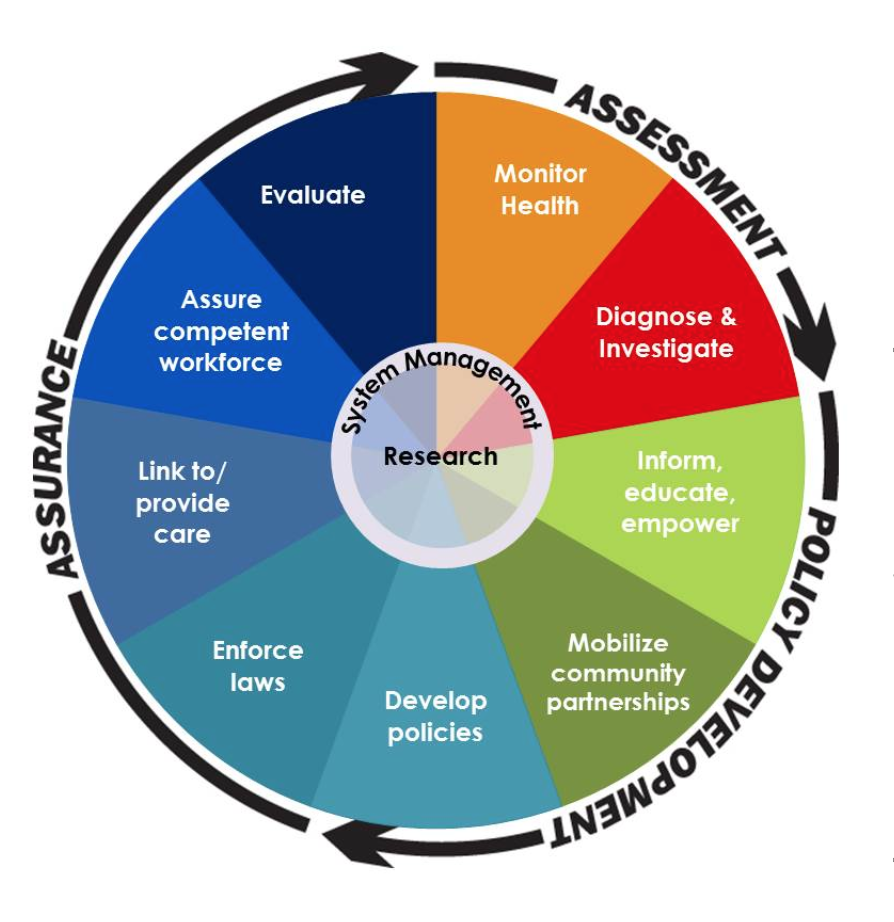
MONITOR HEALTH
Accurate reporting is hampered by no digital reporting, no online access to forms, and VDH request for phone call to report.
Patient post-treatment outcomes are not investigated or documented.
DIAGNOSE & INVESTIGATE
The VDH rate of completed investigations of reported Lyme disease cases dropped in 2018, from 91% to 76% affecting the reliability and usability of Vermont data. Reports and graphs with the 2018 case numbers on the VDH website do not note that many incomplete case investigations were not counted toward the total 2018 surveillance numbers.
INFORM, EDUCATE, EMPOWER
As noted in this report, while the VDH has made significant efforts in tick bite prevention and awareness, education about symptoms, diagnosis, and treatment of Lyme disease is limited and lacking, and many patients in Vermont feel stigmatized and disempowered.
MOBILIZE COMMUNITY PARTNERSHIPS
As noted in this report, VDH community partnerships on TBDs to date seem very limited, and/or not well publicized.
DEVELOP POLICIES
According the VDH, their strategy includes “providing scientifically accurate information on Lyme disease to Vermonters” but policies regarding the inclusion of some evidence-based information and exclusion of other evidence-based information are unclear. Policies for providing thorough and equitable information to the public, and Vermont’s health care providers, are unclear. Policies regarding the VDH goal of “conducting surveillance for the disease” and addressing the effects of incomplete investigations and the related reporting of incorrect data are unclear.
LINK TO PROVIDE CARE
While VDH website pages for other illnesses list community resources and medical experts available to Vermonters, there are no such resources listed on the tickborne diseases web pages.
ASSURE COMPETENT WORKFORCE
As noted in this report, equitable and thorough resources for health care providers from the VDH regarding the diagnosis and treatment of Lyme disease are still limited and/or flawed. The 5-question test providing CE credits for Vermont health care providers, about a disease with such high incidence rates, reveals that expectations for health care providers training and competence are still too low.
EVALUATE
It is unclear if the VDH is adequately evaluating their methods of addressing the impact of tickborne diseases on Vermonters. Per their goals, this would include prevention, reporting, signs and symptoms recognition, and health care provider education about diagnosis and treatment. Prior reports by the VDH to Vermont’s state legislature have been documented to have significant inconsistencies, errors, and omissions.
CONCLUSION
The VDH states that it works with “Community Partners” to address tickborne diseases in Vermont. According to the Vermont Medical Society’s ‘Health Care Public Policy Priorities for 2019’, “The increasing incidence of tickborne illness presents a significant threat to the health and well-being of all Vermonters.” To address this threat, and the above concerns with the way the the VDH is addressing Lyme disease in Vermont, it is VTLyme.org’s hope that the VDH will collaborate with VTLyme.org, and other stakeholders in Vermont, to ensure accurate surveillance, continuing prevention efforts, and access to comprehensive and equitable information for Vermont’s health care providers about the diagnosis and treatment of Lyme disease and tickborne diseases. VTLyme.org looks forward to meeting with the VDH soon to discuss the collaboration suggestions at the beginning of this document, and other ways VTLyme.org can support the VDH to address the impacts of Lyme disease and tickborne diseases on Vermonters.

